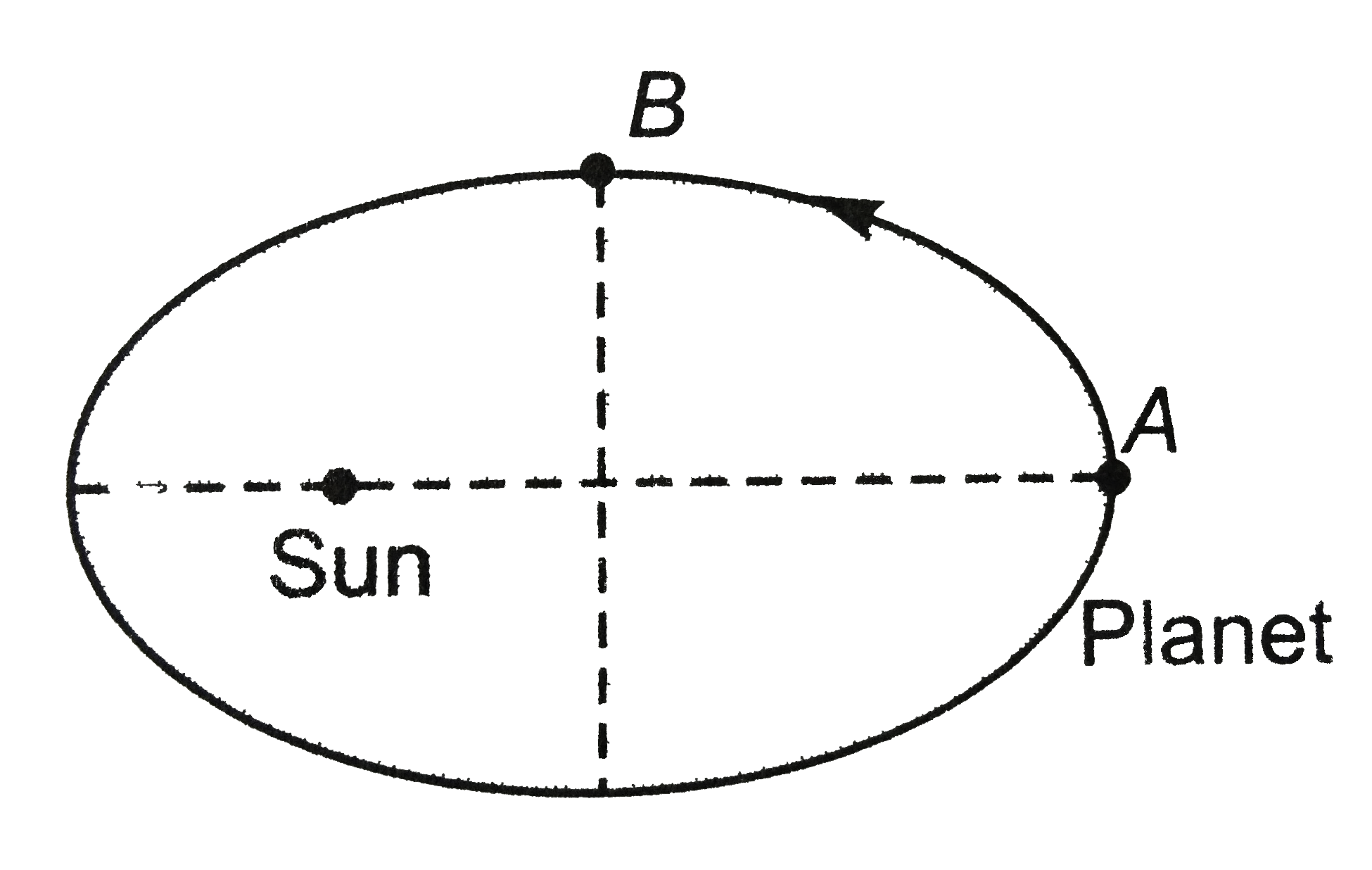A planet moves faster at
Aphelion
Perihelion
Focus
It travels with uniform speed
The correct Answer is:B
To solve the question regarding the speed of a planet at different points in its orbit, we can follow these steps:
1. Understanding the Terms:
- Aphelion: The point in the orbit of a planet where it is farthest from the Sun.
- Perihelion: The point in the orbit of a planet where it is closest to the Sun.
- Phobos: A moon of Mars, not relevant to this question.
2. Conservation of Angular Momentum:
- The angular momentum (L) of a planet in orbit is conserved. This can be expressed as:
L=m⋅v⋅r
- Here, m is the mass of the planet, v is its orbital speed, and r is the distance from the Sun.
3. Setting Up the Equation:
- For two different points in the orbit (let's say perihelion and aphelion), we can write:
m⋅v1⋅r1=m⋅v2⋅r2
- We can simplify this to:
v1⋅r1=v2⋅r2
4. Analyzing the Relationship:
- Rearranging the equation gives:
v1v2=r2r1
- This indicates that the speed v is inversely proportional to the distance r from the Sun.
5. Identifying Minimum and Maximum:
- At perihelion, the distance r is at its minimum (let's denote it as rmin).
- At aphelion, the distance r is at its maximum (denote it as rmax).
- Since v is inversely proportional to r, when r is minimum, v will be maximum.
6. Conclusion:
- Therefore, the planet moves faster at perihelion, where it is closest to the Sun.
Final Answer:
The planet moves faster at perihelion.
- Aphelion: The point in the orbit of a planet where it is farthest from the Sun.
- Perihelion: The point in the orbit of a planet where it is closest to the Sun.
- Phobos: A moon of Mars, not relevant to this question.
- The angular momentum (L) of a planet in orbit is conserved. This can be expressed as:
L=m⋅v⋅r
- Here, m is the mass of the planet, v is its orbital speed, and r is the distance from the Sun.
- For two different points in the orbit (let's say perihelion and aphelion), we can write:
m⋅v1⋅r1=m⋅v2⋅r2
- We can simplify this to:
v1⋅r1=v2⋅r2
- Rearranging the equation gives:
v1v2=r2r1
- This indicates that the speed v is inversely proportional to the distance r from the Sun.
- At perihelion, the distance r is at its minimum (let's denote it as rmin).
- At aphelion, the distance r is at its maximum (denote it as rmax).
- Since v is inversely proportional to r, when r is minimum, v will be maximum.
- Therefore, the planet moves faster at perihelion, where it is closest to the Sun.
The planet moves faster at perihelion.
Topper's Solved these Questions
- GRAVITATION BOOK - AAKASH INSTITUTE ENGLISHCHAPTER - GRAVITATION EXERCISE - ASSIGNMENT SECTION -B (Objective Type Questions (one option is correct))
20 Videos
- GRAVITATION BOOK - AAKASH INSTITUTE ENGLISHCHAPTER - GRAVITATION EXERCISE - ASSIGNMENT SECTION -C (Objective Type Questions (More than one option are correct))
12 Videos
- GRAVITATION BOOK - AAKASH INSTITUTE ENGLISHCHAPTER - GRAVITATION EXERCISE - Try Yourself
33 Videos
- ELECTROSTATIC POTENTIAL AND CAPACITANCE BOOK - AAKASH INSTITUTE ENGLISHCHAPTER - ELECTROSTATIC POTENTIAL AND CAPACITANCE EXERCISE - ASSIGNMENT SECTION - D
9 Videos
- KINETIC THEORYBOOK - AAKASH INSTITUTE ENGLISHCHAPTER - KINETIC THEORYEXERCISE - EXERCISE (ASSIGNMENT) SECTION - D Assertion - Reason Type Questions
10 Videos
Similar Questions
Knowledge Check
Assertion: The planet move slower when they are farther from the Sun than when they are nearer.
Reason : Angular velocity of a planet is a constant quantity.AIf both assertion and reason are true and reason is the correct explanation of assertionBIf both assertion and reason are truebut reason is not the correct explanation of assertionCIf assertion is true but reason is falseDIf both assertion and reason are false.A planet revolves around the sun in an elliptical orbit. Suppose that the gravitational attraction between the sun and the planet suddenly disappear then the planet would move
Atowards the sun in a spiral pathBaway from the sun along a straight path with continuously increasing speedCwith constant speed along a tangential path to the oribtDtowards the sun along a straight path with constant speedAssertion : Microwaves are better carrier of signals than optical waves
Reason : Microwaves move faster than optical waves.AIf both assertion and reason are true and reason is the correct explanation of assertionBIf both assertion and reason are true but reason is not the correct explanation of assertionCIf assertion is true but reason is falseDIf both assertion and reason are false
Assertion: The centre mass of an electron and proton, when released moves faster towards proton.
Reason: Proton is heavier than electron.
View SolutionA planet moves around the sun. It is closest to sun to sun at a distance d1 and have velocity v1 At farthest distance d2 its speed will be
View SolutionWhen a planet moves around the sun
View SolutionAs the temperature of a substance increases, its molecules move faster and thus the kinetic energy of the molecules increases.
View SolutionIn elliptical orbit of a planet, as the planet moves from apogee position to perigee position to perigee position, match the following columns
Column-IColumn-II(A)Speed of planet(p)Remains same(B)Distance of planet from centre of sun(q)Decreases(C)Potential energy(r)Increase(D)Angular momentum about centre of sun(s)Cannot say
View Solution

